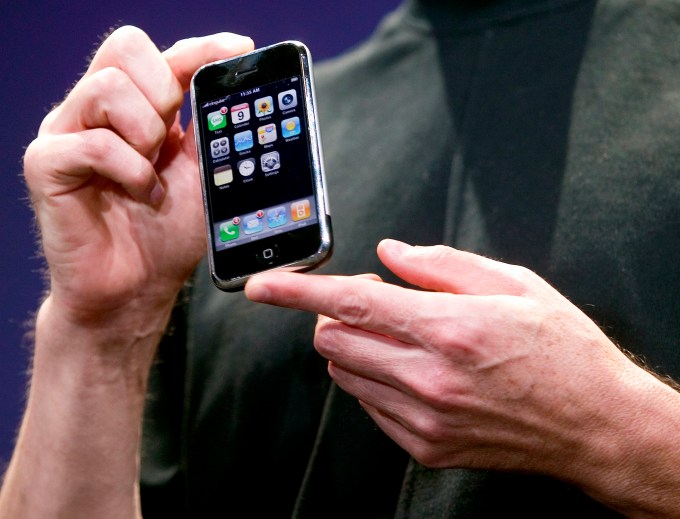… it was nice pressing you. Well, at least some of the thousands and thousands of times. Apple has finally abandoned a feature that’s been a staple of its smartphones since the very start, over a decade ago: A physical home button.
The trio of almost-all-screen iPhones unboxed today at its Cupertino HQ go all in on looks and swipes, with nothing but a sensor-housing notch up top to detract from their smoothly shining faces.
Last year Apple only ditched the button on its premium iPhone X handset, retaining physical home buttons on cheaper iPhones. But this year it’s a clean sweep, with buttons dropped across the board.
If you want to go home on the new iPhone Xs, iPhone Xs Max or iPhone Xr (as the trio of new iPhones are confusingly named) well, there’s a gesture for that: An up swipe from the bottom edge of the screen, specifically. Or a look and that gesture if your phone is locked.
This is because Apple has also gone all in on its facial biometric authentication system, Face ID, for its next crop of iPhones — throwing out the predecessor Touch ID biometric in the process.
“Customer love it!” enthused Apple’s marketing chief, Phil Schiller, talking up Face ID from the stage, after CEO Tim Cook had reintroduced the tech by collapsing it all to: “Your phone knows what you look like and your face becomes your password.”
“There’s no home button,” confirmed Schiller, going over the details of the last of the three new iPhones to be announced — and also confirming Face ID is indeed on board the least pricey iPhone Xr. “You look at it to unlock it… you look at it to pay with Apple Pay,” he noted.
So hey there Face ID, goodbye Touch ID.
Like any fingerprint biometric Touch ID is fallible. Having been doing a lot of DIY lately it simply hasn’t worked at all for my battered fingertips for more than a month now. Nor does it work well if you have dry skin or wet hands and so on. It can also be hacked with a bit of effort, such as via silicone spoofs.
Still, Touch ID does have its fans — given relative simplicity. And also because you can register multiple digits to share biometric access to a single iPhone with a S.O. (Or, well, your cat.)
Apple has mitigated the device sharing issue by adding support for two faces per device being registered with Face ID in iOS 12. (We haven’t tested if it’ll register a cat yet.)
However the more major complaint from privacy advocates is that turning a person’s facial features into their security and authentication key normalizes surveillance. That’s certainly harder to workaround or argue against.
Apple will be hoping its general pro-privacy stance helps mitigate concerns on that front. But exactly how the millions of third party apps running on its platform make use of the facial biometric feature is a whole other issue, though.
Elsewhere, debate has focused on whether Face ID makes an iPhone more vulnerable to being force unlocked against its owner’s will. The technology does require active interaction from the registered face in question for it to function, though — a sort of ‘eyes-on’ check and balance.
It’s probably not perfect but neither was a fingerprint biometric — which could arguably be more easily forcibly taken from someone in custody or asleep. But it’s irrefutable that biometrics come with trade-offs.
None of these technologies is perfect in security terms. Arguably the biggest problem is there’s no way to change your biometric ‘password’ if your data leaks — having your fingerprints or face surgically swapped is hardly a viable option.
Yet despite such concerns the march towards consumer authentication systems that are robust without being hopelessly inconvenient has continued to give biometrics uplift.
And fingerprint readers, especially, are now pretty much standard issue across much of the Android device ecosystem (which may also be encouraging Apple to step up and away now, as it seeks to widen the gap with the cheaper competition).
In the first year of operation its Face ID system does appear to have been impressively resilient, too — barring a few cases of highly similar looking family members/identical twins. Apple is certainly projecting confidence, now, going all in on the tech across all its iPhones.
If you’re inconsolable about the loss of the Home Button it’s not entirely extinct on Apple hardware yet: The iPad retains it, at least for now. And if it’s Touch ID you’re hankering for Apple added the technology to the MacBook Pro’s Touch Bar (on 2016 models and later).
Yet the days of poking at a physical button as a key crux of mobile computing do now look numbered.
Contextual computing — and all it implies — is the name of the game from here on in. Which is going to raise increasingly nuanced questions about the erosion of user agency and control, alongside major privacy considerations and related data ethics issues, at the same time as ramping up technological complexity in the background. So no pressure then!
At the end of the day there was something wonderfully simple about having a home button always sitting there — quietly working to take people back to a place they felt comfortable.
It was inclusive. Accessible. Reassuring. For some an unnecessary blemish on their rectangle of glass, for sure, but for others an important touchstone to get them where they needed to go.
Hopefully Apple won’t forget everything that was wrapped around the home button.
It would certainly be a shame if its spirit of inclusiveness also fell by the wayside.

Photo by Kim Kulish/Corbis via Getty Images


from iPhone – TechCrunch https://ift.tt/2xclnEO

